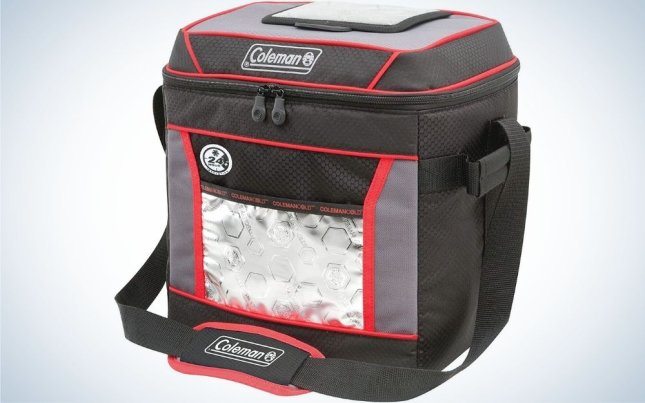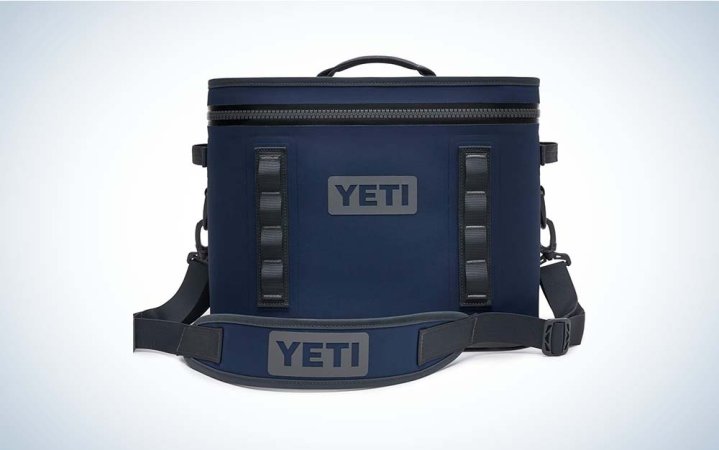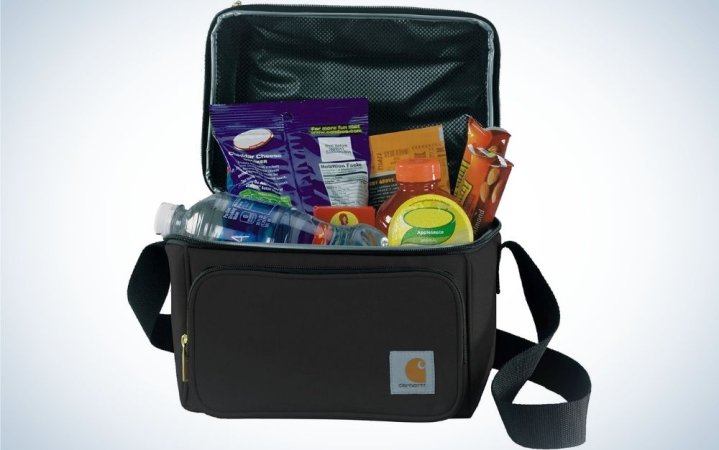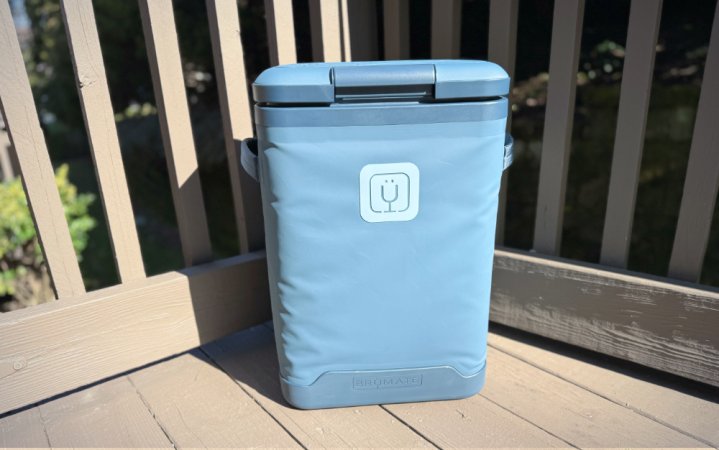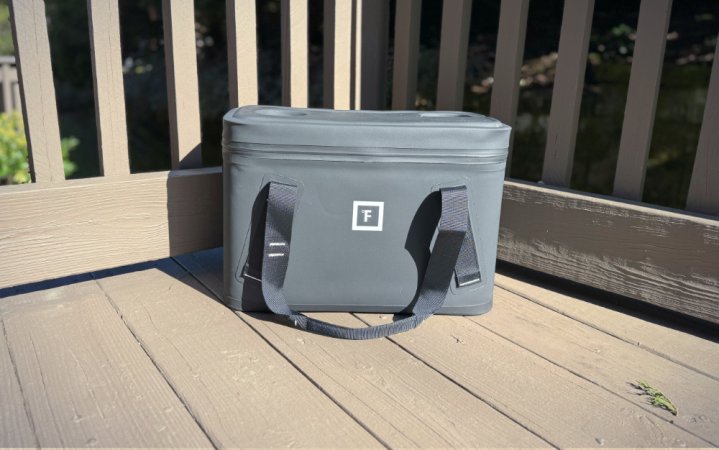We may earn revenue from the products available on this page and participate in affiliate programs. Learn more ›
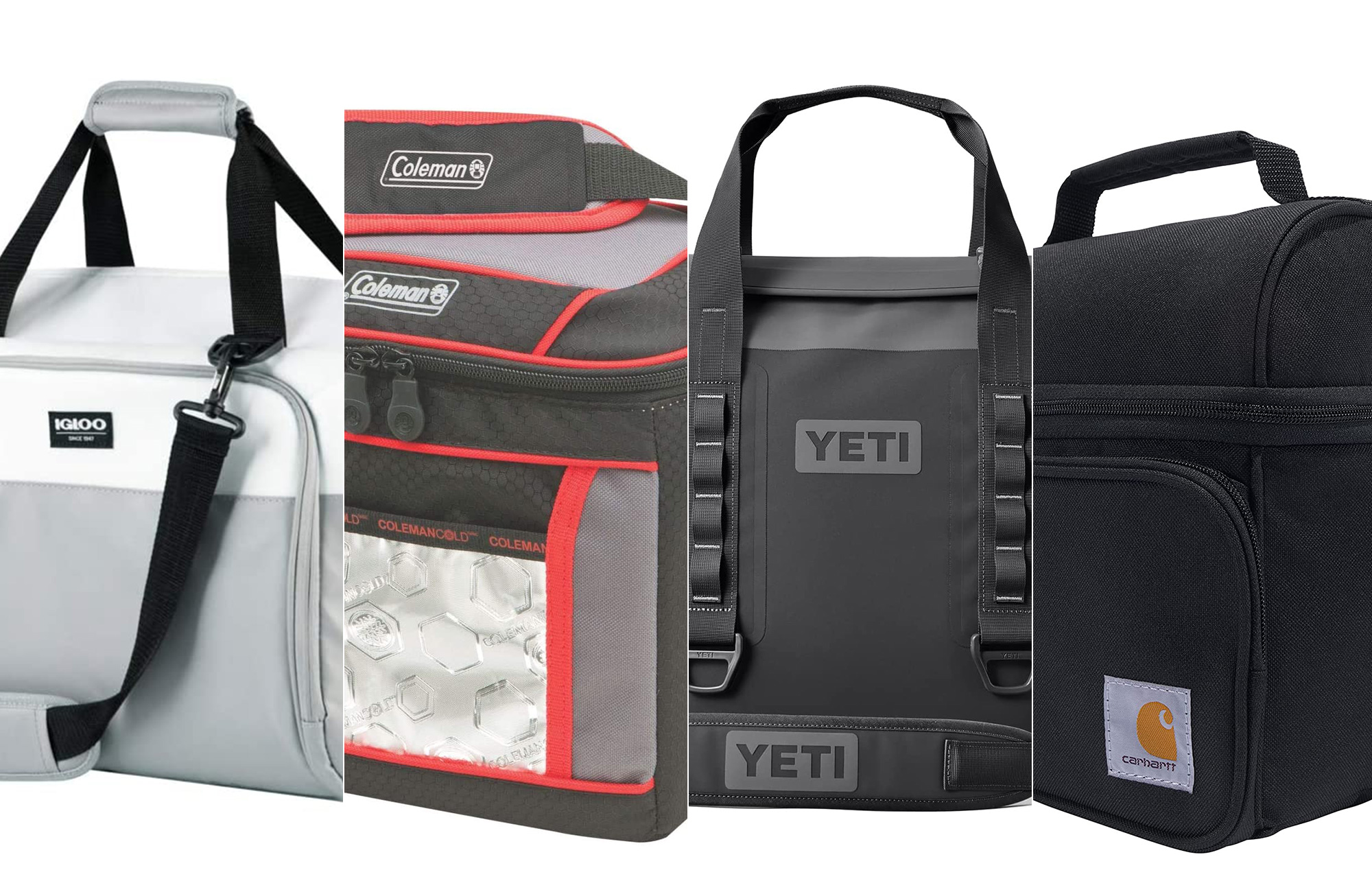
You’ll be shocked how frequently a cooler bag comes in handy. They can keep drinks frosty on a hot day at the beach, keep lunch fresh during a long work day, or prevent your frozen groceries from thawing on the way home from the store. You’ll find every type of soft cooler out there, from heavy-duty waterproof versions to simple insulated vessels meant to take minimal abuse. We’ve researched dozens of the most popular models to develop this list of the best cooler bags for every person and type of outing.
- Best overall: Yeti Hopper Flip 18
- Best small: Carhartt Deluxe Dual-Compartment Insulated Lunch Cooler Bag
- Best collapsible: Igloo 36-Can Snapdown
- Best backpack: Brümate MagPack 24-Can Backpack Soft Cooler
- Best soft-sided: Iron Flask Soft Cooler Bag
- Best value: Coleman Soft Cooler Bag
How we chose the best cooler bags
Cooler bags are a hot commodity because they don’t require the amount of space (or expense) as a full-sized cooler. There are dozens of popular models on the market vying to keep your cans and lunch containers cool. We started with a wide survey of the product space and narrowed it down based on personal experience, user feedback, editorial reviews, and general reputation. We put several models through typical activities, including trips to the beach and toting lunches. For the best results, it’s still important to know how to pack a cooler and nail the ice-to-drinks ratio properly.
The best cooler bags: Reviews & Recommendations
From the boat and the beach to the jobsite or campsite, insulated bags keep your food and drinks at your desired temperature. Here are the best cooler bags for no matter where you plan to be this summer, whether it’s landscaping or playing backyard games.
Best overall: Yeti Hopper Flip 18
Case Closed
Pros
- Waterproof construction includes the zipper
- Exceptional insulation
- Designed to withstand UV rays and mildew buildup
Cons
- Very expensive
Why it made the cut: With burly construction, superior insulation, and lots of carrying options, this is the champion of cooler bags.
Specs
- Capacity: 30 cans
- Handle type: Hand and shoulder
- Waterproof: Yes
- Price: $300
Yeti has made a name for itself, making some of the best full-sized and roller coolers, and it’s brought that same engineering to its Hopper Flip 18 soft cooler. Its 30-can capacity (without ice) is more than sufficient for a day-long beach trip or hike. Adding ice will lower the number of cans you can bring but increase the amount of time your beverages will stay cold. Yeti says the cooler bag can keep beverages cold for several hours (if not days), though the exact timeframe will depend on your environment and beverage-to-ice ratio. This longevity is possible because of Yeti’s DryHide double-TPU Shell and Coldcell Insulation, which put a dense barrier between the contents of your soft cooler and the outside world.
A leakproof zipper will prevent liquid from getting in and out of the Hopper Flip 18 unnecessarily. Yeti says the materials it uses on the inside and outside of its soft cooler were designed to reduce mildew, and the outside can prevent damage from exposure to UV rays. All of these performance characteristics are common in full-sized coolers, but it’s impressive Yeti was able to keep cramming them into a much lighter, more portable cooler design. There are still some features—like the ability to use dry ice for cooling—that are exclusive to Yeti’s full-sized coolers, but all of the essentials are here.
Best small: Carhartt Deluxe Dual Compartment Insulated Lunch Cooler Bag
Going Outside the Box
Pros
- Extremely durable outer
- Shoulder and hand straps
- Extra front pocket for more storage
- Holds a 6-pack for when you’re off the clock
Cons
- Shoulder strap is sewn on so it’s not removable
- Capacity may be small for some large lunches if you’re also adding an ice pack
Why it made the cut: This basic lunch bag is built super-tough and keeps food cold long enough for really late lunches.
Specs
- Capacity: Six cans
- Handle type: Shoulder strap and carry handle
- Waterproof: Yes
- Price: $29.50
Don’t let this small cooler’s size fool you; its ultra portability doesn’t mean it’s less performant than our other recommendations. It’s made of 1,200-denier polyester, designed to resist water and protect your food. The soft cooler’s thermal insulation will keep hot foods hot or keep up to six canned beverages cold for several hours. At just 10 inches wide and nine inches tall, this soft cooler was designed to be taken on quick trips to the beach or onto a job site. A front zippered pocket can be used to hold utensils, small sauce bottles, or other paraphernalia, while a top compartment can hold more cans or be used to keep food and beverages separated. A carry handle and shoulder strap make this Carhartt lunch cooler bag easy to cart to any jobsite.
Best backpack: Brümate MagPack 24-Can Backpack Soft Cooler
Best backpack
Pros
- Kept beverages cool for over 24 hours
- Shoulder straps were comfortable
- Magnetic lock was easy to open but stayed firmly shut
Cons
- Price
Why it made the cut: This big but portable soft cooler is easy to carry around and can keep drinks cold for days.
Specs
- Capacity: 24 cans
- Handle type: Shoulder straps
- Waterproof: Yes
- Price: $274.99
The most premium model in Brümate’s newly launched MagPack line of soft coolers is this 24-can backpack, and it’s worth every cent of its comparatively high price. The inner layers of the backpack are constructed using a proprietary technology called “IceShield” to insulate your beverages and a waterproof shell around the outside to keep any unwanted pests from getting inside. Both of these elements made the soft cooler feel solid both inside and out. We never felt like we’d damage it by moving it in and out of a car or casually dropping ice and cans into its inner chamber, then shaking them around to ensure even distribution. Our favorite design element was this cooler’s magnetic latch, which was powerful enough to prevent drinks and ice from spilling out when the backpack was turned upside down but easy enough to open one-handed.
Brümate says you can fill this cooler with up to 24 cans plus ice, 21 pounds of only ice, or seven bottles of wine with ice. We filled it with 18 cans and roughly 10 pounds of ice and left them to sit overnight. After 12 hours, it looked as if virtually no ice had melted, and the cans felt colder to the touch than when we put them in. We continued to check on our beverages at 12-hour intervals, and it was well into the second day before the ice almost completely melted. At that point, the soft cooler kept the water from the melted ice cool enough that we could grab chilled cans for several additional hours. (The cooler was left in an environment of roughly 68 degrees.)
Carrying the MagPack around was comfortable, as there was enough padding in the back and slack in the straps to make the proper adjustments. Its straps were removable, though, so we could carry it around single-handed or double-handed using its side straps. It’s nice to have this versatility, just in case. If you need a backpack cooler to keep your beverages chilled this summer, we highly recommend checking out Brümate’s MagPack 24-Can Backpack Soft Cooler.
Best collapsable: Igloo 36-Can Snapdown
Built for the beach
Pros
- Very spacious
- Front pocket provides extra storage for sunscreen or other essentials
- Sturdy handles
- Solid insulation
- Fold-down opening makes for easy loading
Cons
- Heavy when fully loaded
- No dividers if you want to carry other items besides cans
Why it made the cut: With lots of room for beverages and a very secure fold-down design, it’s an ideal way to pack for the coast.
Specs
- Capacity: 36 cans
- Handle type: Hand and shoulder straps
- Waterproof: Yes
- Price: $58.75
This rectangular bag unfolds at the top to create a large opening for easy loading. It weighs just 1.7 pounds when it’s empty. That’s crucial because it holds up to 36 cans and ice, which makes it hefty when loaded to capacity. The sturdy hand straps feel very secure, and the included shoulder strap is removable, so it won’t flop around when you’re not using it. This insulated cooler bag’s large, flat front pocket is roomy enough to hold silverware, sunscreen, a Kindle, or whatever other beach essentials you might want to lug along. I brought it along to an all-day fitness competition, and it kept my lunch, some protein shakes, and a few cans of energy drinks chilled nicely, even without adding ice. The fold-down opening does a good job of keeping out sand and other debris from the environment, but the lining can wrinkle, making it tricky to clean. This is ultimately a very solid replacement for those wasteful foam coolers they sell at the supermarket. It’s a lot sturdier, too.
Best soft-sided: Iron Flask Soft Cooler Bag
Iron Flask Soft Cooler Bag
Pros
- Exceptional insulation
- Solid capacity
- Drink holders on top
Cons
- Price
Why it made the cut: Iron Flask’s soft-sided cooler is a well-constructed day-trip-friendly choice for campers and beachgoers.
Specs
- Capacity: 24 cans
- Handle type: Straps and handles
- Waterproof: Yes
- Price: $170.95
Iron Flask’s Soft Cooler Bag impressed by living up to the company’s claims that beverages would stay cold for two whole days—though that does mean sacrificing some can space in the name of ice. Our tests used the suggested 12 cans and about 10 pounds of ice in a 68-degree environment, and we could continue to grab cold drinks from it for a couple of days. What impressed us the most about this soft-sided cooler was its design. The cooler’s handles and strap felt solid, making it easy for us to carry it around. A pair of circular cutouts on top of the cooler provided convenient spots to hold drinks, while a built-in bottle opener ensured we’d always have one on us at a moment’s notice. The cooler bag’s design makes it the perfect choice for carting around on a commuter/cargo bike, too.
Iron Flask said its soft cooler was rip-resistant and leakproof, and we put the latter statement to the test by leaving ice water inside, shaking it around, and keeping the cooler upside down. Water didn’t get through, so you shouldn’t have any leaking issues while transporting beverages or keeping water in this soft cooler bag in a car or on the beach overnight. By using the right insulation, Iron Flask was able to coax the maximum amount of performance from a lighter weight soft cooler bag. While it’s a little more expensive than the competition, you’re certainly getting what you paid for.
Best budget: Coleman Soft Cooler Bag
Cool Customer
Pros
- High capacity
- Flip-open top makes for easy access
- Folds down when empty for easy transport
Cons
- Not waterproof or leak-proof, so best for packaged products
- No handle for hand-carrying
Why it made the cut: This roomy bag provides solid insulation and lots of space to cover various uses.
Specs
- Capacity: 30 cans
- Handle type: Shoulder strap
- Waterproof: No
- Price: $33
This may not be the least expensive soft cooler we recommend, but its 30-can capacity is impressive given its sub-$50 price tag. Even on 90-degree Fahrenheit days, this Coleman soft cooler bag can keep 30 cans cold for 24 hours because it has heat-welded leakproof seams and robust insulation. While hardly bulletproof, the nylon exterior has an antimicrobial lining designed to keep out odor, mold, mildew, and fungus. Plus, the ripstop fabric is made to prevent tears. That’s plenty of protection for a budget buy. The soft cooler bag also features side handles and an adjustable shoulder strap for easy transport, plus a front pocket to store your keys or bottle opener.
What to consider when shopping for the best cooler bags
Whether you need them for play or work, the best cooler bags have one main job: maintaining your food’s temperature. Bags accomplish this through insulation, leakproof seams, and other features. Just in time for you to pack that picnic, we’ve unpacked what you need to look for in a cooler bag.
Insulation
Insulation is the primary way the best cooler bags keep food cold—or hot, for that matter. Most bags feature thermal insulation, which keeps food or drinks at the desired temperature by stopping heat transfer. Think about it: If you place a hot mug of coffee on the counter, the beverage will slowly cool to room temperature. But suppose you put it in a concealed environment. In that case, it’ll transfer its heat energy to the inside of that space while simultaneously pulling heat energy from the air around it until the temperature of both the coffee and that concealed space settles somewhere in between.
A cooler bag’s insulation helps win the heat-transfer battle, and the best cooler bags use foam insulation. The gas bubbles in the foam, as well as the porous spaces between those bubbles, help slow heat transfer. But not all foam is the same. Open-cell foam is lighter and more flexible—making it an easier fit for soft-sided coolers. However, it doesn’t stop the transfer of heat as well as closed-cell foam, which does a better job of limiting the interaction between the gas bubbles. Brands such as Yeti have created foam insulation that’s light and soft enough for bags, bringing the best of thermal to soft-sided coolers. Of course, expect to pay higher prices for technology that so effectively keeps the temperature up (or down).
Seams
Seams are critical in a soft cooler bag because they prevent leaks of all kinds. One type of leak is apparent—if the seams aren’t tight and your bag of marinating chicken spills, you’ll be cleaning your trunk, as well as your cooler. (Also, if you’re planning to dump ice into your insulated bag, weak seams could lead to a wet picnic blanket.)
While not as messy, the other kind of leak could be just as problematic. Remember, they work by creating a perfectly concealed environment to prevent heat transfer. Leaky seams compromise that environment by allowing air to flow in and out.
So what should you look for in a cooler’s seams? Rather than being stitched or glued together, the best cooler bags—the most airtight, that is—are welded together with heat and pressure. The seal on top of the bag also factors in. While zippers are most common—and perfectly suitable—Yeti has developed a magnetic seal that’s nearly as tight as a drybag.
Durability
The outside of your cooler bag is important since that material determines waterproofing and other protections. A fabric’s deniability refers to the thickness of each thread, and anything above “1,000 denier” should provide ample resistance to water, mildew, and the sun. Many bags also feature breathable, elements-resistant linings—à la Gore-Tex.
Size
Soft bags can have as much capacity as blocky hard coolers. But if you plan to use it as a lunch box rather than a camping refrigerator, you’d be foolish to opt for the 30-can model. Still, a bigger bag can accommodate more ice, giving you the option of keeping food chilled for longer. Plus, the advantage of the best soft cooler bags over hard coolers is that they are packable, often folding down or rolling up in a way that lets them take up just a fraction of the space when they’re empty.
Extras
When your cooler bag is loaded with a case of beer and a bag of ice, you may need an extra set of hands. Models with handles, as well as shoulder straps, offer more ways—and more places—to grab and lift. Extra pockets are useful, too. Some bags have two insulated pockets, allowing you to keep your leftovers warm on top and your beer cold down below. Front and side pockets provide the perfect places to stash your dry goods or your keys.
FAQs
Many soft coolers are waterproof. They feature protective shells or linings that also keep mold, mildew, and the sun’s rays at bay.
You can absolutely put ice in an insulated bag. The interior linings of the best options are completely leakproof, with seams that are welded together. Some even include pourable spouts, letting you easily drain water as the ice melts without requiring that you take out all of your food or drinks.
Depending on the cooler bag you choose, your food can stay cold for hours or days. As a reference point, Coleman’s budget bag boasts that it can keep 30 cans cold for 24 hours. Of course, the quality of the insulation technology is important—with Yeti’s closed-cell foam, such as in the Yeti Hopper M30, leading the way—but size also matters. The bigger the bag, the more ice it can hold and, therefore, the longer your bag will have ice to keep your food cold.
In most cases, you can clean out a cooler bag by sloshing water around it and using mild dish soap inside to prevent bacteria or odors from building up. If a spill has occurred, you may want to use a sponge to clean the inside more thoroughly. Rinsing off the outside of a cooler bag will be sufficient to keep it clean.
Soft-sided coolers are generally lighter but keep beverages cooler for a shorter period of time. Hard-sided coolers typically use denser materials as insulation, which adds to their weight and cooling capabilities. There’s no wrong answer, and the best choice will come down to your personal preference.
This depends on their size, capacity, and materials. Our recommendations cost between $33 and $275.
Final thoughts on shopping for the best cooler bags
- Best overall: Yeti Hopper Flip 18
- Best small: Carhartt Deluxe Dual-Compartment Insulated Lunch Cooler Bag
- Best collapsible: Igloo 36-Can Snapdown
- Best backpack: Brümate MagPack 24-Can Backpack Soft Cooler
- Best soft-sided: Iron Flask Soft Cooler Bag
- Best value: Coleman Soft Cooler Bag
Whether you’re looking for frosty beers or fresher produce, an insulated bag is like a portable refrigerator that packs up easily when it’s emptied. With thermal bags’ foam insulation systems and airtight seals, the best cooler bags can keep your hot food warm and your cold cuts cool. The size and style you need depend on what you want to eat and drink and where you want to consume it—maybe at a pier or a picnic table. But no matter if you’re looking to tip back a few cold ones on a boat deck or eat a hot sandwich while constructing a client’s back deck, there is an option that’s right for you.


